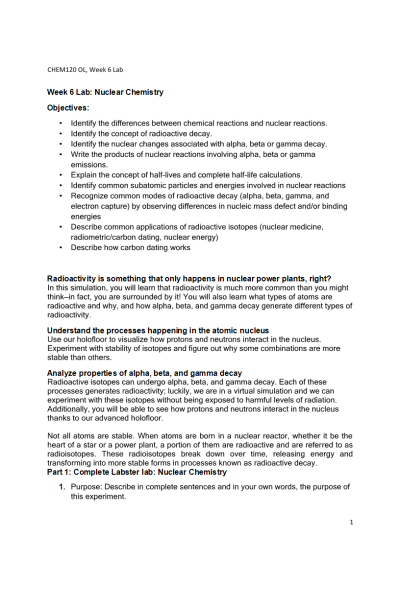CHEM 120 Week 6 Virtual Lab; Part I, Part II, Part III
-
$25.00
| Institution | Chamberlain |
| Contributor | Karin Austin |
Document Preview
Week 6 Lab: Nuclear Chemistry Objectives:
- Identify the differences between chemical reactions and nuclear reactions.
- Identify the concept of radioactive decay.
- Identify the nuclear changes associated with alpha, beta or gamma decay.
- Write the products of nuclear reactions involving alpha, beta or gamma emissions.
- Explain the concept of half-lives and complete half-life calculations.
- Identify common subatomic particles and energies involved in nuclear reactions
- Recognize common modes of radioactive decay (alpha, beta, gamma, and electron capture) by observing differences in nucleic mass defect and/or binding energies
- Describe common applications of radioactive isotopes (nuclear medicine, radiometric/carbon dating, nuclear energy)
- Describe how carbon dating works
Radioactivity is something that only happens in nuclear power plants, right?
In this simulation, you will learn that radioactivity is much more common than you might think—in fact, you are surrounded by it! You will also learn what types of atoms are radioactive and why, and how alpha, beta, and gamma decay generate different types of radioactivity.
Understand the processes happening in the atomic nucleus
Use our holofloor to visualize how protons and neutrons interact in the nucleus. Experiment with stability of isotopes and figure out why some combinations are more stable than others.
Analyze properties of alpha, beta, and gamma decay
Radioactive isotopes can undergo alpha, beta, and gamma decay. Each of these processes generates radioactivity; luckily, we are in a virtual simulation and we can experiment with these isotopes without being exposed to harmful levels of radiation. Additionally, you will be able to see how protons and neutrons interact in the nucleus thanks to our advanced holofloor.
Not all atoms are stable. When atoms are born in a nuclear reactor, whether it be the heart of a star or a power plant, a portion of them are radioactive and are referred to as radioisotopes. These radioisotopes break down over time, releasing energy and transforming into more stable forms in processes known as radioactive decay.
Part 1: Complete Labster lab: Nuclear Chemistry
- Purpose: Describe in complete sentences and in your own words, the purpose of this experiment.
The purpose of this experiment was to practice nuclear chemistry. I was able to see how radioactive materials changed over time, make predictions about what happens in nuclear reactions, and discover the characteristics of different types of radiation. It's like a hands-on experience in a safe virtual environment……….. Continue
| Instituition / Term | |
| Term | Summer |
| Institution | Chamberlain |
| Contributor | Karin Austin |





-80x80.JPG)



-80x80.JPG)





























































